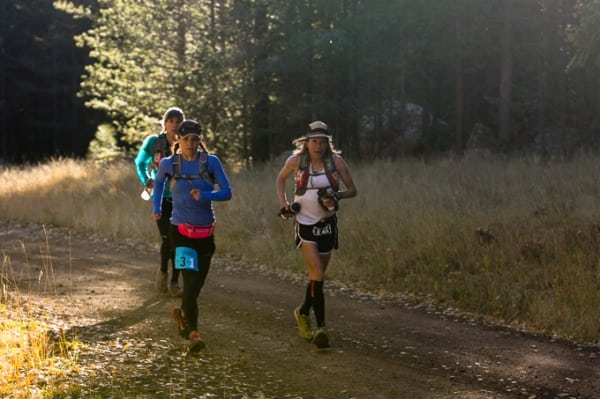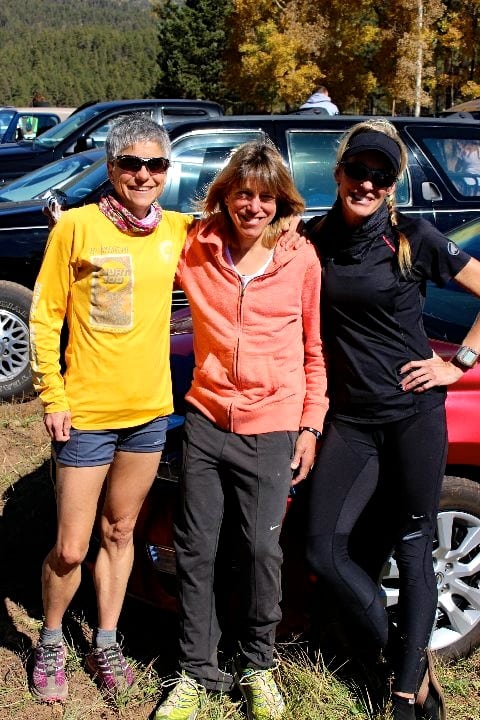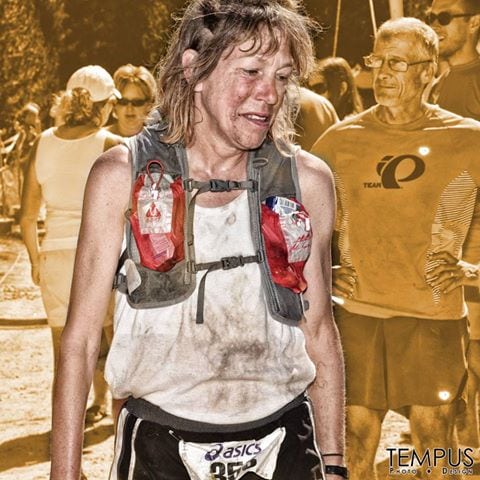[Author’s Note: This week, Ann Trason introduced the Overlook Endurance Runs, 100k, 50-mile, and 50k races on and very close to the revered Western States Trail. She also announced that she’s offering online running coaching. I caught wind of her intentions a couple months back, and became curious. THE Ann Trason, I thought? The Ann Trason who dominated ultrarunning for decades but who stopped racing in 2004 and slowly, surely, and completely dropped off the ultrarunning radar in the years after that? The Ann Trason who suddenly popped up at races around the West–volunteering, pacing, and running–this past summer? I decided, the backstory has to be good, and I want to write about it. The only problem was that, over the last decade, Ann’s turned down almost all interviews. I am grateful that she agreed to this one.]
It’s a chilly, sunny, winter morning, and the only place I can get cell service is the porch of my house. I’m bundled up but still a little shivery as I punch some numbers into my phone. I’m nervous as hell, which might also help explain why I’m shaky. It’s mid-morning, but I’ve been awake since the middle of the night, fiddling and worrying about this interview.
It’s not often that you get to interview your idol. Or that you’re about to finally speak with someone who has twice previously declined an interview with you. The numbers I’m punching into my phone belong to the best female ultrarunner of all time, Ann Trason. She may be our sport’s greatest female athlete, but she’s as shy as they get, at least in talking about herself. Ann will later tell me that she was perhaps more nervous for this interview than I was. “I drank 10 cups of coffee in preparation,” she says.

Ann running the 2013 Flagstaff to Grand Canyon Stagecoach Line 100 Mile. Photo: Kristin Wilson
Ann Trason ran her first ultramarathon in 1985, the American River 50 Mile. She won, though she tells me during our mid-January interview that this was despite the fact she didn’t know enough about running this sort of distance to even carry a water bottle. “Someone gave me one. It saved my race,” she explains, laughing. I laugh too, and think, Even the best of the best have the same, steep learning curve.
Her streak of ultrarunning brilliance would last for just shy of the next 20 years. During that time, she won the revered Western States 100 a ghastly 14 times, setting a course record that’s only been beat once, by Ellie Greenwood in 2012. In that time, she finished second overall twice and third overall another three times. In 1995, she was tied for the lead of the whole race with Tim Twietmeyer at mile 85; Tim surged and beat her by roughly five minutes.
During those two decades, she won almost every race she entered and set course records at most of them, too, including still-standing records at the American River 50 Mile, the Wasatch Front 100, and the Leadville 100. She remains the American road 100k record holder, a mark she set at 7:00:48 in 1995. And she won a damn near miraculous double–twice, in both 1996 and 1997–the Comrades Marathon and the Western States 100, which take place less than two weeks apart on different continents.
In doing all this, she forged a pathway for women in what was then an entirely male-dominated sport. “Most times I showed up at training runs, and I was the only woman. Other women would be there as crew and support to their husbands. I wanted them out on the trails with me!”
The Field of Dreams saying goes, “If you build it, he will come.” In ultrarunning’s case, maybe it’s more accurate to say, “If Ann builds it, the women will come.” Because that’s exactly what happened. Ann and a couple other women of her time acted as pioneers–that’s the word that Ann uses–carving a trail for women through a what was then a dude’s sport.
Ann gets nervous when people talk about her race wins, course records, and two-decade-long dominance. So nervous that, during our interview, she’s constantly deflecting questions or turning them around upon me. She says, “What races are on your calendar?” and “Listening to me talk about me must be so boring.” When we finish our interview, I will have to sit on the porch for a while to let the vibrations of our exchanged energy settle out. I wish Ann could understand how much our community values her.
Behind Ann and a couple pioneers like her came first just a few women, and later, some more. Presently, ultrarunning is still male-dominated, but not so ridiculously so as during the 1980s and ’90s. In comparison to 20 years ago, women are flocking into the sport like geese flying south for the winter.
Ann says she’d prefer if the focus about her was on this, instead of on her wins and records. “Really, I was just doing what other women weren’t yet doing. That’s all,” she says.
But there is just no denying her legendary status. The trail Ann built for women to follow has been almost entirely insurmountable. There’s no woman whose results compare to the breadth and depth of Ann’s. Our community has ruminated about Ellie Greenwood as a possible modern iteration of Ann, a woman with enough talent and drive to truly push boundaries. But as awesome as Ellie is, she’s only been at ultrarunning for a couple years. Does she have 20 years worth of equitable dominance? Only time will tell.
I can’t imagine there is one ultrarunner who, after looking at her race results, would say that Ann is not a legend. She was. She is. She will always be. I don’t recommend calling her one, though. I learn this the hard way. During our interview, I ask her what she thinks of being considered a legend by so many members of our community, from those who were running ultras back when she was to all the newbies just arriving to our sport. My question is met by silence, so much of it that I think my shoddy cell service has given out.
“Ann?” I ask. “Are you there?”
When she chooses to speak, it is through quiet sobs and a flood of emotion, “That’s touching. It really is. But I just don’t see myself like that. I don’t. I’m just a woman who ran a lot.”
At the end of 2004, Ann stopped racing ultramarathons. But she was still a part of the ultra community. She was the race director of the Dick Collins Firetrails 50 until 2010 and an occasional volunteer at other races in the San Francisco Bay Area, her home. To say that Ann RD-ed Firetrails 50 is to say that the race operated under Ann’s very loving ship. Attendees of Ann’s race have said they felt Ann’s care right down to details like the aid-station cookies and soups which were all homemade, by her. Yes, all of them.
“It was like putting on a big party for your friends. Dick Collins was a mentor of mine and when he passed away, the race was passed on to me. He really took me under his wing. He wasn’t a top ultrarunner but he symbolized what ultrarunning was to me.” She remembers, “He taught me the most about attitude. He and I ran this 24-hour race and it was pouring rain. I probably wouldn’t have started, except that Dick told me, ‘Come on. Why are you complaining? It’s just rain.’ And so we ran and we had the best time. I was just jumping in the puddles. I loved it. Because of my relationship with Dick, I took directing his race to heart. That’s why my kitchen looked like a hurricane for two months every year.”
After 2010, she gave up that race directorship–passed it on–and then largely disappeared from the community, a ghost vanished to everyone but her closest, California friends. Why did she disappear and where did she go?
It seems that years of injuries finally got the best of her. Says Ann, “Well, since 1995, I had problems. Most people don’t know that, that year, I had a partial tear of my ACL that became a full tear. I ran Comrades and States all those years with an ACL tear. Can you believe it?” Later on in our conversation, Ann adds, “My mother says I’m either all in or all out with something. And she’s right.” When Ann couldn’t run much because of residual issues related to those old injuries, she dropped off the face of the ultrarunning planet.
Instead of ultrarunning, Ann went full bore with road biking, “I rode my bike for 10 years. For my 50th birthday, I rode across America in a tour. I wanted to try something new, that I knew would be hard for me. I wanted to get really out of my comfort zone.”
Ann’s time away from ultrarunning must have also been a protective instinct of sorts. So strong was that instinct that she shied away from almost any ultrarunning-related attention. Like I mentioned before, Ann had declined a couple of interviews with me, and I know other writers were also turned away. One time, she declined by saying the following in an email, “I am just not interested sorry. Not running and it is hard to talk about it. I hope you understand.”
Times have now changed, again. The Legend, er, Pioneer, er bad arse runs again. From an outside observer’s perspective, Ann’s return seems to have begun with her participation the 2013 Western States 100 Veterans’ Panel, which you can watch here. Skip to 8:30 in if you’d like to see the audience give Ann an appropriate greeting after her extended absence. What’s harder to discern in the video is Ann’s response. About that rousing round of applause, Ann tells me, “I cried–well, I cry at everything–I never understood how many people wanted me around. It felt amazing.”
For Ann, the re-entry process back into the ultra community was a gradual one. A while before that veteran’s panel, Ann started coaching middle-school track and cross country. “Those kids are honestly my inspiration.” Ann says that during the first week she was working with them, she injured her Achilles by sprinting around with them too much. “They made running so fun. They made me want to run again.” It took three months for her Achilles to heal, but gradually her running re-started.
Some time after that, Ann says she called up her old Wednesday night trail running group, a small and pretty private group of close friends which runs in the Marin Headlands area, and asked them if she could return. She says she was intimidated, “We used to run so hard and so fast, and now I am slow.” Of course her old running crew opened their arms to her.
I ask Ann why she’s re-involved herself with ultrarunning. “When I was riding my bike, I missed the social aspect of trail running, of running down the trail in this line and talking with people. In biking, there are pace lines, but you can’t really talk in them. It’s just so different. I missed the social-ness! My heart wasn’t into biking the same way that it is into running.”
After the veterans’ panel last year, Ann crewed and paced Christina Williams, a now-30-year-old woman who Ann used to babysit. After handing Christina off to her next pacer at the Rucky Chucky River Crossing at States, Ann was supposed to pace another friend, Steve Holman, to the finish. When Ann received word that Steve had dropped, she went on the hunt for someone else to pace. She found a stranger and paced him to the finish line.

Ann and Christina after Western States in the early ’90s. Photo courtesy of Ann Trason.

Ann and Christina before the 2013 WS100. Photo courtesy of Ann Trason.
Her participation in the ultra community has escalated from there. At the end of August last year, Ann ran the Idaho Mountain Trail Ultra Festival 100 Mile. It took her 33-plus hours. About that race, summarizes Ann, “I was in the worst shape of my life, coming back into running. But I had the best time! I never really thought I would finish a 100 again.”
About two months later in October, Ann says that race director Ian Torrence talked her into running the inaugural Flagstaff to Grand Canyon Stagecoach Line 100 Mile. “I made all the same rookie mistakes I used to. I’d forgotten how to do everything,” says the now-53-year-old. “I had really great people helping me but I was fighting those cutoffs! I barely made them.”

Ann at the Flagstaff to Grand Canyon Stagecoach Line 100 Mile. Photo courtesy of Ann Trason.
And she’s already registered for at least one race in 2014, the River of No Return 100k in Idaho.
There’s more on Ann’s plate, too, than just running. In addition to coaching middle-school running, she’s starting her own, online running coaching business. And she’s getting back in the business of race directing with the inaugural Overlook Endurance Runs, which will take place on and around the Western States Trail next September.
“I love the Western States Trail, love it. Look, I’m not a Zen master when I run, but there’s something special about that trail. Can trails be your friends? It’s a friend to me. I am excited I can help people run on it. It’s so hard to get into the Western States 100, but that doesn’t mean people shouldn’t be able to run on the trail itself.”
Ann continues, “I’m so excited about coaching and race directing. I feel like this is my place now, to help people with their running. I feel like this is my way of contributing to a community that has been such a friend to me.”

Ann doing trail work on the Western States Trail after the American Fire in 2013. Photo courtesy of Ann Trason.
In her descriptions of directing the Firetrails 50, Ann describes how she let the details–of making all the food for hundreds of runners, and more–consume her. I joke with her, asking her if the same thing will happen with the Overlook Endurance Runs. She deadpans her response, “I’ll probably make the soup. But I’ve learned, there’s a reason for Costco.”
She continues, “I’m a detail-oriented person. I thrive on details. Putting together the courses was like eating candy. Getting to know and working with the agencies approving our permits is even fun. I’m honestly having a blast putting these races together.”
In her return to running, Ann says she worries about disappointing people. Her thoughts on this come out like a passionate speech on speed and aging and women in ultrarunning:
“I’m not fast anymore. I have this hitch in my step. I might always. I’ve lost a ton of my muscle. I just don’t want to compete. I don’t have that competitive side in me anymore. Like my mom says, I’m off or on. The competition button is just off now. Will people be disappointed if I’m not the same Ann as I used to be? If I don’t win races? I don’t want them to be. It kills me to think I might disappoint people. There are so many women in their fifties who are running fast. They are strong. They are beautiful. I admire them, look up to them. I feel proud that I’m in the same age bracket as them. But I don’t want to be them. I want to just run. I love how it makes me feel. I just want to be a part of the community as much as I can.”
Before I spoke with Ann, I would have described her return to ultrarunning by saying something like, “Ann’s back.” But now that I’ve gotten to know her just a little, learned a smidge of her story, I’m more inclined to say that she never left. It seems like Ann’s relationship with the ultrarunning community is like an ultra itself.
Sometimes, in a really long ultra, we’ve got to take a long break. We’re talking a nap on a cot, an hour in the chair, four pukes in the woods, some period of time where we sit things out and let our bodies and minds undergo a system re-set. After that, we get up and go again. Our speed after that reset might be the same or even faster than when we started. But more often than not, it’s a slower, more leisurely form of forward progress.
That’s the metaphor my mind now settles on for Ann. She hung out in an aid station for a while, and now she’s back on course. Ann, long may you run (at whatever pace you wish).

Ann after finishing the IMTUF 100 in 2013. Photo: Tony Salazar of Tempus Photo Design
[Editor’s Note: This is the latest edition of iRunFar’s On Adventure article series, a play on words from the climbing phrase ‘on belay.’ On Adventure strives to document the raddest adventures of sport and life undertaken by trail and ultrarunners.]
